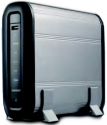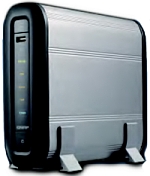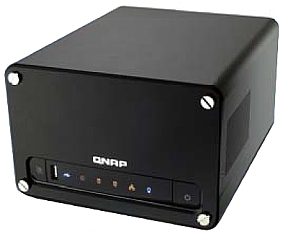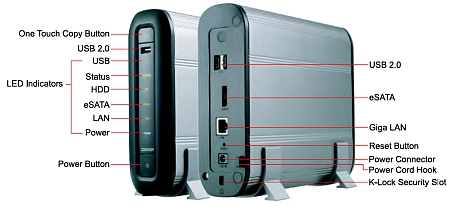NAS gadget serves multimedia to PS3, Xbox 360
Oct 10, 2007 — by LinuxDevices Staff — from the LinuxDevices Archive — 7 views[Updated Oct. 16] —  Qnap Systems has updated the firmware for its Linux-powered multifunction NAS (network-attached storage) devices, adding DLNA media-sharing capabilities usable with Sony's PlayStation3 and Microsoft's Xbox 360. The TS-109 and TS-209 accommodate up to 2TB of storage, and provide an extensive list of server and storage features.
Qnap Systems has updated the firmware for its Linux-powered multifunction NAS (network-attached storage) devices, adding DLNA media-sharing capabilities usable with Sony's PlayStation3 and Microsoft's Xbox 360. The TS-109 and TS-209 accommodate up to 2TB of storage, and provide an extensive list of server and storage features.


Qnap's TS-109 (left) and TS-209 (right) NAS devices
(Click each image to enlarge)
The TS-109, introduced in July, supports up to 1TB storage on an internal SATA hard drive. Total storage can be expanded to 2TB by means of external eSATA or USB drives. The compact device features a fanless design and aluminum alloy case, according to the company, and its power consumption is said to be less than 14.4W in normal operation. The TS-209, introduced in August, is similar to the TS-109 but provides a built-in second drive.
Both devices are based on Marvell 5182 SoCs, featuring ARM cores clocked at 500MHz. Both have 8MB of Flash, and 128MB of DDRII SDRAM.
On the software side, both Qnap devices run a 2.6.12 Linux kernel, together with Qnap's self-maintained Linux implementation. Open source packages include SAMBA, proftpd, httpd, busybox, bittorrent/ bittornado, and nfsd, with “all the Linux development done by QNAP's in-house R&D team,” stated Ivan Hsu, QNAP spokesperson.

TS-109/TS-209 networking and services possibilities
Touted features common to both devices include:
- File server — The NAS device administrator can create user IDs and passwords, and define file access authority and storage quotas for each user.
- FTP server — Users can can easily manage the access authority of the FTP server and share their files with others.
- Backup server — Automatic backup software (NetBak Replicator) allows users to perform real-time synchronization or schedule backup from multiple PCs to the NAS.
- RAID-1 mirroring — The NAS supports RAID 1 mirroring to either an internal drive (TS-209 only) or external USB or eSATA drives. It provides email and LED alarms in the event of a crash. An “intelligent data rebuilding” feature provides automatic data recovery to a swapped-in drive.
- Remote replication — Files can be backed up between Qnap NAS devices (including to remote locations). Options include encryption, data compression, block level incremental backup, and data synchronization.
- Web server — Editable php.ini support simplifies the setting up a web server.
- MySQL server — The NAS functions as a standalone database server. It can be used as a database server for a remote web server, or as an additional backup database server for system redundancy.
- Printer server — A USB printer connected to the device's USB port can easily be shared over the network.
- UPnP media server — Built-in TwonkyMedia Server software establishes a convenient media storage center that with UPnP/DLNA-compliant (Digital Living Network Alliance) media players. This function allows users to transmit photos, videos, and Internet Radio streams from the device to a TV — no PC is needed.
- Photo sharing — When users upload photos the NAS, the device automatically generates a web-based photo album with thumbnails, which can then be browsed from a PC's web browser.
- Download station — The NAS can function as a download machine, via BitTorrent, FTP, or HTTP, without requiring the user's PC to be turned on. Users can download directly through a web browser or they can install Qnap's proprietary QGet download utility.
- iTunes server — The user's MP3 files stored on the NAS can easily be streamed to Mac or Windows PCs.
The devices provide the necessary network file-sharing protocols to share files with Windows (all versions), Mac, Linux, and Unix systems, according to Qnap. Additionally, DLNA media playing support built into the TS-109 and TS-209 alows multimedia files stored on the devices to be automatically transmitted over the home network to a PS3 (video resolution can be up to 1080p) or Xbox 360.
The units run an unspecified version of “embedded Linux,” the company says. They use the EXT3 filesystem for their internal hard drives, and support a choice of EXT3, FAT, and NTFS (read only) filesystems for external hard drive formats. Supported networking protocols are said to include TCP/IP, DHCP client and server, CIFS/SMB, AFP, NFS, HTTP, HTTPS, FTP, NTP, and Jumbo Frame, according to Qnap.

TS-109 connections
(Click to enlarge)
Key specifications of the hardware, as listed on the company's data sheet, include:
- Processor — “high-speed” system-on-chip
- Memory — 128MB DRAM; 8MB flash
- Hard drive capacity:
- TS-109 — 1 x 3.5-inch SATA I/II drives (not included), up to 1TB internal, expandable to 2TB total storage via external eSATA or USB drives
- TS-209 — 2 x 3.5-inch internal SATA I/II drives (not included), for up to 2TB total storage
- LAN port — 1 x Gigabit Ethernet (RJ-45)
- USB — 3 x USB 2.0 (support printer, disk, digital camera, pen drive, card reader, and USB hub)
- LEDs — USB, status, eSATA, HDD, LAN, power
- Dimensions:
- TS-109 — 8.3 x 7.2 x 2.4 inches (210 x 182 x 60 mm)
- TS-109 — 8.5 x 6.9 x 4.5 inches (214 x 175 x 115 mm)
- Power:
- Operating — 14.4W
- Sleep mode — 6.6W
The devices appear to be available now. The TS-109 and TS-209 are listed for $285 and $415, respectively (without drives), at NewEgg.com and are also offered by a number of other online retailers.
This article was originally published on LinuxDevices.com and has been donated to the open source community by QuinStreet Inc. Please visit LinuxToday.com for up-to-date news and articles about Linux and open source.